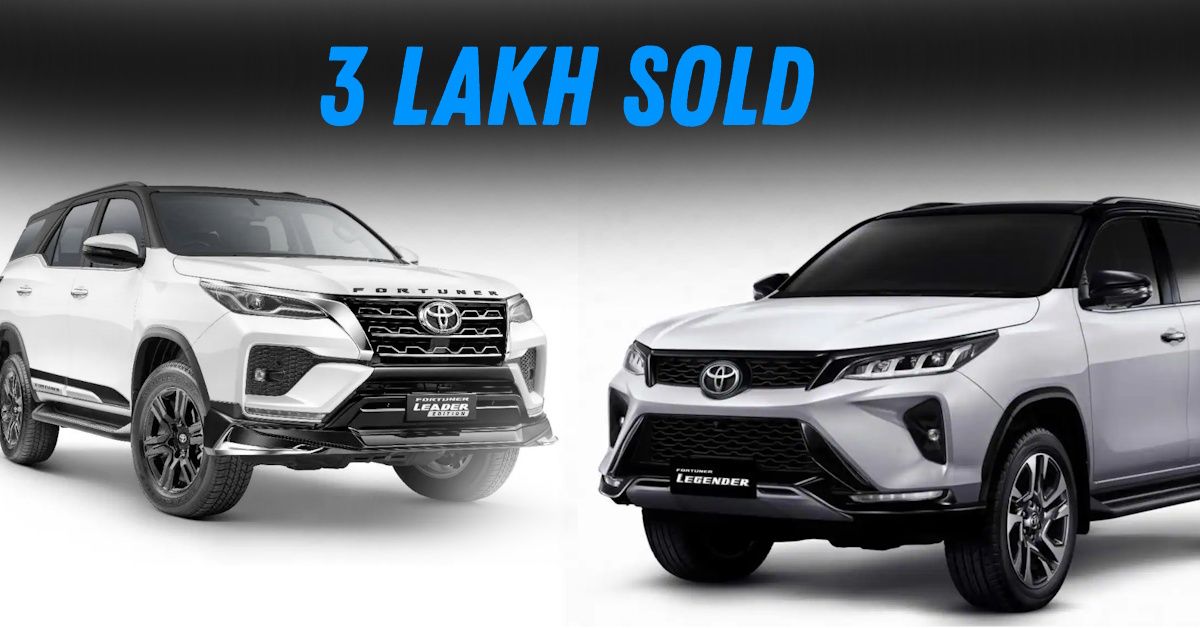Toyota Fortuner and Legender Cross 3 Lakh Sales Milestone in India


Three lakh units sold. That’s the milestone Toyota’s Fortuner and its more stylised sibling, the Legender, have now crossed in India. It’s a number that reflects not just brand success, but also the lack of credible alternatives in a segment where real competition has quietly faded away.
The Fortuner has had an unbroken sales run since its launch in 2009, and it remains the default choice for buyers looking at full-size ladder-frame SUVs. In April 2025 alone, nearly 2,900 units were sold, reflecting a 25 percent year-on-year growth. That’s a strong figure, especially for a vehicle priced well above most mid-size SUV rivals.
Yet these numbers tell more than just a story of popularity. They also expose a void. With Ford pulling out the Endeavour, Mitsubishi long gone, and Chevrolet not even in the picture anymore, Toyota has been operating in a market with few genuine threats. Alternatives like the MG Gloster, Jeep Meridian, or the Isuzu MU-X exist, but none have managed to unsettle the Fortuner’s dominance.
Mechanically, the Fortuner delivers on most of what buyers expect from a tough, go-anywhere SUV. The 2.8-litre diesel engine offers 201 bhp and 500 Nm of torque, with early torque delivery that makes it easy to drive despite its size. The availability of manual and automatic gearboxes, and a 4WD option, further broadens its appeal.
Where it lags, however, is in refinement. The engine is noisy by modern standards, cabin insulation is average, and ride comfort, especially in the rear, is still body-on-frame bouncy. In urban use, this lack of finesse becomes more obvious, especially when cross-shopping with unibody SUVs that cost far less but offer a smoother experience.
Toyota hasn’t aggressively added tech features either. The infotainment system feels dated, digital instrumentation is missing, and even some convenience features found in ₹20 lakh SUVs are absent. Buyers clearly aren’t coming here for gadgets.
If engineering explains how the Fortuner performs, reliability explains why it continues to sell. Few vehicles in India enjoy such a bulletproof reputation. Stories of Fortuners running beyond two lakh kilometres with minimal trouble are common, and Toyota’s aftersales network reinforces this peace of mind.
Add to that the resale value. Few premium SUVs retain value like the Fortuner. It’s one of the rare ₹40 lakh-plus vehicles where depreciation doesn’t bite too hard. Buyers factor this in. It makes the higher initial price easier to digest and adds to the Fortuner’s practical appeal, especially for business buyers and fleet owners.
The Fortuner’s sheer size and road presence remain key selling points. It looks like it costs money and has become something of a status marker in both urban and semi-urban India. The Legender version builds on this with cosmetic upgrades like LED indicators, dual-tone paint, and a few premium touches like wireless charging and a JBL sound system, but underneath, it's the same vehicle.
These styling tweaks have helped Toyota appeal to private buyers who don’t want a bare-bones fleet car, but they don’t mask the fact that many interior materials and design elements still feel a generation behind.
Perhaps the most remarkable aspect of the Fortuner’s success is how little competitive pressure it faces. With no real threat from other body-on-frame SUVs, Toyota has had the luxury of moving at its own pace. Price hikes have come steadily over the years, but the market has absorbed them. Buyers looking for true SUV capabilities have limited options, and Toyota knows it.
Even when compared with the Harrier or Safari, which are cheaper and more feature-packed, many buyers still pick the Fortuner for its image, perceived durability, and straightforward ownership experience. That speaks volumes about brand trust, but also about how little the competition has done to challenge it on core attributes like reliability or resale.
Toyota’s achievement here is less about product brilliance and more about understanding the Indian buyer. The Fortuner isn’t perfect; it’s expensive, a bit rough around the edges, and lags behind in features. But it works. It delivers the promise of longevity, keeps costs predictable, and looks the part.
The three lakh milestone validates this strategy. In a country where many buyers are still wary of fancy electronics or turbocharged complexity, the Fortuner’s old-school recipe continues to win. As the industry slowly shifts toward electrification and software-led experiences, this SUV remains rooted in what many still value most: mechanical honesty, low-maintenance ownership, and the reassurance that it will still feel solid a decade down the line.